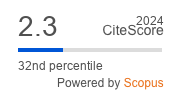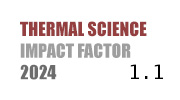ABSTRACT
To thoroughly evaluate both the comfort and energy consumption aspects of thermal environment regulation models, a low-energy building model centered on human comfort was investigated and developed. This model was based in an analysis of indoor building thermal environment characteristics and active-passive thermal environment regulation technologies that prioritized human comfort. The research confirmed the efficacy of the proposed low-energy building model focused on human comfort. The predicted average voting index for this building demonstrated greater stability compared to other models, fluctuating within the range of –0.5 to 0.5. Furthermore, the percentage of dissatisfied individuals in this model stood at 9.7%, which was lower than that observed in other models. In addition, the study engaged 500 participants to conduct a satisfaction survey regarding the thermal environment regulation performance of the model. The satisfaction ratios for temperature, humidity, and wind speed were 87.2%, 79.8%, and 78.5%, respectively, all of which surpassed those of other models. Moreover, the energy consumption of this model was 6.1 kW/h, with an energy efficiency ratio of 6.5, outperforming other models in this regard. In summary, the low-energy building model based on human comfort, developed through this research, excels in meeting human comfort needs by adjusting temperature, humidity, and wind speed. Additionally, its superior energy consumption control performance offers theoretical support for the advancement of green and environmentally friendly building thermal environment regulation technologies in the future.
KEYWORDS
PAPER SUBMITTED: 2025-06-03
PAPER REVISED: 2025-04-11
PAPER ACCEPTED: 2025-05-14
PUBLISHED ONLINE: 2025-07-05
THERMAL SCIENCE YEAR
2025, VOLUME
29, ISSUE
Issue 4, PAGES [2915 - 2934]
- Varma, P. S., Anand, V., Intelligent Scanning Period Dilation Based Wi-Fi Fingerprinting for Energy Efficient Indoor Positioning in IoT Applications, J. Supercomput, 79 (2023), 7, pp. 7736-7761
- Shi, S., et al., Energy Consumption Prediction of Steelmaking Process Based on Improved Whale Optimization Algorithm and Stochastic Configuration Network, JOM, 75 (2023), 10, pp. 4320-4331
- Cano-Ortega, A., et al., Smart Meter for Residential Electricity Consumption with TLBO Algorithm for LoRaWAN, Electr. Eng., 105 (2023), 4, pp. 2021-2040
- Tian, M., et al., Addressing Localized Thermal Comfort Needs of the Human Body Through Advanced Personal Thermal Management Garments Design and Evaluation, Text. Res., J., 95 (2025), 3-4. pp. 429- 449
- Sun, Z., et al., A Miniaturized Wireless Passive Frequency Selective Surface Sensor for High-Temperature Applications, IEEE Sens. J., 22 (2022), 23, pp. 22734-22740
- Lajunen, A., et al., Review of Cabin Thermal Management for Electrified Passenger Vehicles, IEEE TVT, 69 (2020), 6, pp. 6025-6040
- Zhang, J., et al., Thermal Optimization of High-Temperature Downhole Electronic Devices, IEEE T-CPMA, 11 (2012), 11, pp. 1816-1823
- Geng, X., et al., A Lightweight Approach for Passive Human Localization Using an Infrared Thermal Camera, IEEE Internet ThINGS, 9 (2022), 24, pp. 24800-24811
- Scarcello, L., et al., Pursuing Energy Saving and Thermal Comfort with a Human-Driven DRL Approach, IEEE T. Hum-Mach Syst., 53 (2023), 4, pp. 707-719
- Jaguemont, J., et al., Investigation of a Passive Thermal Management System for Lithium-Ion Capacitors," IEEE T. Veh. Technol., 68 (2019), 11, pp. 10518-10524
- Liu, Q., et al., Surrogate-Assisted Many-Objective Optimization of Building Energy Management, IEEE Comput. Intell. M., 18 (2323), 4, pp. 14-28
- Yu, L. et al., A Review of Deep Reinforcement Learning for Smart Building Energy Management, IEEE IoTJ, 8 (2021), 15, pp. 12046-12063
- Ahrarinouri, M., et al., Multiagent Reinforcement Learning for Energy Management in Residential Buildings, IEEE TII, 17 (2021), 1, pp. 659-666
- Tsioumas, E., et al., Enhanced Sizing Methodology for the Renewable Energy Sources and the Battery Storage System in a Nearly Zero Energy Building, IEEE Tpel., 36 (2021), 9, pp. 10142-10156
- Zhang, X., et al., An Edge-Cloud Integrated Solution for Buildings Demand Response Using Reinforcement Learning, IEEE T. Smart Grid, 12 (2021), 1, pp. 420-431
- Logan-Jackson, A. R., et al., A Critical Review on the Factors that Influence Opportunistic Premise Plumbing Pathogens: From Building Entry to Fixtures in Residences, Environ. Sci. Technol., 57 (2023), 16, pp. 6360-6372
- Zhou, H., et al., Model Simulation of Thermal Environment and Energy Effects of Rooftop Distributed Photovoltaics, Glob. Energy Interconnect., 7 (2024), 6, pp. 723-732
- Eslamirad, N., et al., Data Generative Machine Learning Model for the Assessment of Outdoor Thermal and Wind Comfort in a Northern Urban Environment, Fron. of Archit. Res., 12 (2023), 3, pp. 541-555
- Kim, S., Ahn, J., Building Space Thermal Control Model Responding to Sharp Changes in Outdoor Temperature, Tech. Gaz., 30 (2023), 3, pp. 815-823
- Monte Sousa, F., Callou, G., Analysis of Evolutionary Multi-Objective Algorithms for Data Center Electrical Systems, Computing, 107 (2025), 2, pp. 1-27
- Wang, Y., et al., Waste Haven Transfer and Poverty-Environment Trap: Evidence from EU, Green Low- Carbon Econ., 1 (20230, 1, pp. 41-49
- Khan, F. A., et al., Energy Optimization in Smart Urban Buildings Using Bio-Inspired Ant Colony Optimization, Soft Comput., 27 (2023), 2, pp. 973-989
- Khan, N., et al., Deep Autoencoder-Based Hybrid Network for Building Energy Consumption Forecasting, Comput. Syst. Sci. Eng., 48 (2024), 1, pp. 153-173
- Yamin, N., Bhat, G., Indoor-Outdoor Energy Management for Wearable IoT Devices With Conformal Prediction and Rollout, IEEE T. Comput. Aid D., 43 (2024), 11, pp. 3370-3381
- Kumar, S. S., et al., Enhancing Grid Stability and Efficiency in Buildings Through Forecasting and Intelligent Energy Management of Distributed Energy Resources, Electr. Eng., 106 (2024), 6, pp. 7491-7508
- Nandishand, B. M., Pushparajesh, V., Efficient Power Management Based on Adaptive Whale Optimization Technique for Residential Load, Electr. Eng., 106 (2024), 4, pp. 4439-4456
- Charles, D., The Lead-Lag Relationship Between International Food Prices, Freight Rates, and Trinidad and Tobago's Food Inflation: A Support Vector Regression Analysis, Green and Low-Carbon Economy., 1 (2023), 2, pp. 94-103
- Huang, Z., et al., A Matrix Translation Model for Evacuation Path Optimization, IEEE T. Intell. Transp., 25 (2024), 4, pp. 1374-1383
- Yuan, Y., Bai, C., Energy-Saving Diagnosis of Public Buildings Based on Multi-Objective Optimization Algorithm, Intell. Build. Int., 16 (2024), 1/2, pp. 59-72
- Nazari, S., et al., Optimisation of Commercial Buildings Envelope to Reduce Energy Consumption and Improve Indoor Environmental Quality (IEQ) Using NSGA-II Algorithm, Int. J. Ambient. Energy, 44 (2023), 1, pp. 918-928
- Chen, J. et al., Changes in Agricultural Land Requirements for Food in China 1990-2020: A Comparison Between Urban and Rural Residents, Polish J.l of Environmental Studies, 34 (2025), 2, pp. 1027-1037

